Helgafellssveit 作者: 来源: 发布时间:2021-06-15
一、所属省或是州,具体位置,人口,面积
Helgafellssveit is a municipality in Iceland located on the Northwest side of Snæfellsnes in Iceland’s Northwest Constituency. It is the smallest municipality by population in Iceland. In january 2017 inhabitants of Helgafellssveit municipality were only 52. It has a total area of 250 square kilometers (49th largest in Iceland). It has a population density of 0.26 inhabitants / km².
The population decline from 1981 to 2004 was 45%. The population has increased again since 2005:
Dec. 1, 1981: 85
Dec. 1, 1997: 66
Dec. 1, 2003: 52
Dec. 1, 2004: 47
Dec. 1, 2005: 55
Dec. 1, 2006: 58
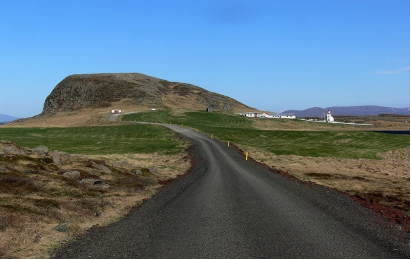
二、自然地理
1.地理条件
Helgafellssveit is located within Snæfellsnes which is a long headland in western Iceland between Faxaflói to the south and Breiðafjörður to the north. Fjallgarður runs along the length of the headland but the highest mountain on the headland is Snæfellsjökull (1446 m) which is a cone of fire. Snæfellsjökull is famous for the alleged mystical forces that are said to live in it and for being the starting point for the adventures of the protagonists in the book The Mysteries of Snæfellsjökull by Jules Verne.
Some are built along the shores of the headland and several urban cores on its north coast, they are Stykkishólmur, Grundarfjörður, Ólafsvík, Rif and Hellissandur, counted from east to west, but all these are villages and towns that base their income mostly on fishing. To the south are two small towns, Arnarstapi and Hellnar. To the west of the headland was in previous years an extermination station in Dritvík and then the village of Beruvík, which has been deserted for many decades.
The neo-volcanism on Snæfellsnes - it started again two million years ago after a pause of about five million years - are highly alkaline ejecta rocks. This applies to all three active volcanic systems on Snæfellsnes: Snæfellsjökull, Lýsuskarð and Ljósufjöll.
This also applies to the Berserkjahraun lava field, which was created around 4000 years ago. The lavas emerged from a row of craters consisting of four craters of the Ljósufjöll volcanic system. You are between Kerlingarskarð and Seljafell. In the east lies Rauðakúla (379 m), then Gráakúla (211 m), Smáhraunakúla and in the west Kothraunskúla (191 m). The eruption started in Kothraunskúla. Then followed the craters Rauðakúla and Gráakúla and finally the smallest crater Smáhraunakúla. It covers a large part of the west of the municipality of Helgafellssveit. On both sides of the mountainBjarnarhafnarfjall the lavas have poured themselves into the sea.
Two lakes formed in the eruption when the lavas dammed streams: Selvallavatn and Kothraunsvatn. Both lakes have only underground drains.
They are mostly difficult to cross aa lavas made of alkali olivin basalt.
The lava field is now under nature protection.
https://de.wikipedia.org/wiki/Berserkjahraun
2.交通情况
Helgafellssveit is about 169 kilometers north of Reykjavik and can be reached by car in a little over 2 hours in good driving conditions. The largest Urban town near to Helgafellssveit is Stykkishólmur, which is only 6 kilometers to the North.
三、经济发展和规模
In Helgafellssveit, the maximum return is collected. Tax revenue per capita in 2012 amounted to ISK 479,621, when the contribution of the Local Government Equalization Fund is included, which is slightly above the national average. It is estimated that the municipality will receive over ISK 7 million in contributions from the Municipal Equalization Fund. The municipality's debt at the end of 2012 amounted to 38.4% of annual income. According to Íslandsbanki's summary from February 2013, Helgafellssveit was one of the municipalities with low debt, but operations are still not subject to indebtedness in general, based on given assumptions. This information was compiled from the municipalities' annual accounts for 2011.
https://www.ruv.is/frett/helgafellssveit
四、产业特点/重点项目
The main industries are agriculture and fisheries. However, no information can be found on specific companies or specifics within the municipality.
Just over a third of companies in the Northwest constituency have income from culture and the arts. About 5% of companies have income from culture and the arts in whole or in large part. Almost 30% of companies have some or little income from culture and the arts, while 65% of companies have no income from that activity.
Other production, construction, trade, accommodation and catering, information technology were significantly more of the opinion that they had income from culture and the arts. Fisheries, mining, energy companies and finance and insurance companies considered themselves completely free of such connections. There was no significant difference in this position between regions within Western Iceland.
There has long been an interest in knowing the importance of the creative industries in the West. Traditional industry classification does not provide such information. As a result, companies in the West were asked to what extent they had income from culture and the arts. They could choose between answering; entirely, to a large extent, to some extent, to a small extent and to no extent. The answers should therefore provide an indication of the importance of the creative industries in the West.
The Association of Local Authorities in Western Iceland conducted the survey among companies in Western Iceland. Almost 200 companies responded to the survey, which is considered a fairly good response rate. In the survey, West Iceland was divided into four areas. They are called Akranes and Hvalfjörður, Borgarfjarðarsvæði, Snæfellsnes and Dalir. The municipalities of Akranes and Hvalfjarðarsveit were Akranes and Hvalfjörður, Borgarbyggð and Skorradalshreppur Borgarfjarðarsvæði. Eyja- og Miklaholtshreppur, Stykkishólmsbær, Helgafellssveit, Grundarfjarðarbær and Snæfellsbær were called Snæfellsnes and Dalabyggð alone formed Dali.
http://ssv.is/frettir/184182/
五、风景名胜,景点( attractions)
1. Snæfellsjökull National Park
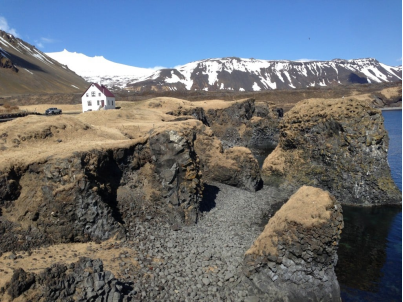
Snæfellsjökull National Park was established on June 28th, 2001.The Park's purpose is to protect and conserve the area's unique landscape, indigenous plants and animal life as well as the important historical relics. At the same time, the Park is meant to allow visitors easier access as well as an improved opportunities to get to know the area. National parks are amongst Iceland's finest assets and everyone is free to explore them.The Snæfellsjökull glacier lies within the national park, and the park is the only Icelandic national park that stretches to the sea. The geology of Snæfellsnes national park is diverse with formations from almost every era of Iceland’s past. The more prominent formations in and around the National Park mainly date from geologically “modern” times back to the last ice age. The hills to the north of the glacier, around Bárðarkista, are of volcanic palagonite tuff, formed during eruptions under the glacier or below the surface of the sea. Svalþúfa is most likely the eastern section of a crater that erupted under the sea, while Lóndrangar is a volcanic plug.
https://www.west.is/en/inspiration/snaefellsjokull-national-park
2. Berserkjahraun Lava Field
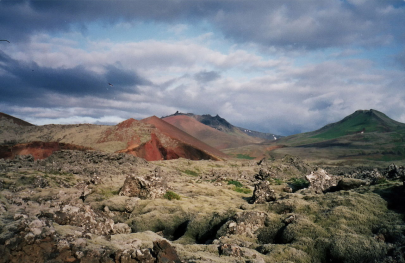
The Berserkjahraun lava field, with its rows of craters, is located in the west of Iceland . It belongs to the Ljósufjöll volcanic system and is located in the north of the Snæfellsnes peninsula near Helgafellssveit.
The lava field takes its name from events that are described in one of the Icelandic sagas, the Eyrbyggja saga (13th century). They are probably also mentioned in an older source, the Heiðarvíga saga, but the original has not been preserved.
Accordingly, the Viking Vermóður came into the lava field with two brothers who were berserkers from Sweden. After a while the wild guys grew over his head and he gladly passed them on to his brother Víga-Styrr. After a while he also had his problems with the strong and unruly men. Halli, one of the brothers even wanted Ásdís, his master's daughter, to be a wife. Víga-Styrr apparently gave in at first, but made one condition: the berserker should find a way through the lava to Bjarnarhöfnbuild and also build a small fortification in the lavas. The two berserkers succeeded. But Víga-Styrr did not keep to the agreement and instead had the two killed and buried in the Berserkjahraun.
You can actually still find a clearly recognizable path that dates back to the Middle Ages and leads through the lava field to Bjarnarhöfn, and on it both a small fortification and the grave of two men. Archaeologists excavated bones there.
https://de.wikipedia.org/wiki/Berserkjahraun
3. Helgafell Church
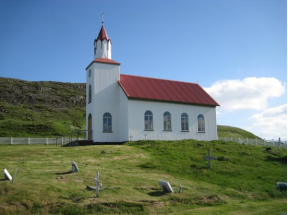
Helgafell is located about 2 miles south of Stykkisholmur. You can park near the farm and walk down the road to the church and graveyard. Whoever walks up Helgafell is granted 3 wishes, but only after having fulfilled the following conditions: 1. Begin by walking to the grave of Gudrunar Osvifursdottir (located between the church & the base of Helgafell, it's surrounded by a white fence) and make the sign of the cross over it. 2. Next, walk in silence up the mountain, looking neither to the right nor the left. 3. Finally, after having reached the top, walk into the rock quarry and while looking towards the East, quietly and sincerely make three wishes. Tell no one the wishes. This was a fun experience climbing to the top of Helgafell and the scenic view of the surrounding area was worth the short hike.
https://www.tripadvisor.com/LocationPhotoDirectLink-g189983-d312359-i72029895-Helgafell-Stykkisholmur_West_Region.html
六、历史文化
1.历史
The Helgafell is a hill 73 m high and is located in western Iceland on the Snæfellsnes peninsula. It is located just under four kilometers south of the town of Stykkishólmur in the municipality of Helgafellssveit.
The name means Holy Mountain in English. The name comes from pagan times and refers to the place of a Viking shrine , which is why there are so many mountains with this name in Iceland.
Þórólfur Mostraskegg, the first settler in this area in 884, considered the Helgafell to be a sacred mountain that no one should see unwashed and on which no one, including animals, should be killed. He believed that he and his relatives would enter the mountain after they died. Later, Guðrún Ósvífursdóttir, the main character of the Laxdæla saga, had a church built on Helgafell and lived there as a hermit until her death. Guðrún is buried near the present church. In 1184, the Augustinian monastery was moved from the island of Flatey to Helgafell. Remains of ruins can still be seen.
Popular belief says that when you climb Helgafell for the first time you have three wishes, and you have to go up from the grave of Guðrún. You shouldn't turn around, talk or talk to anyone about your wishes.
2. 文化体育
Guðrún Ósvífursdóttir, one of the main characters in Laxdæla, lived in Helgafell for the latter part of her life. There she was buried according to Irish tradition. On the way, a monument is made of stone from Helgafell with the year 1008, but the stone was placed on the way in 1979.
In 1184, a monastery of the Augustinian rule was moved from Flatey to Helgafell, and after that the place was an educational center and the capital of academic activity in Western Iceland.
Up on Helgafell is a ruin, loaded with boulders that are believed to be the ruins of the monks' chapel.
https://www.west.is/is/west/place/helgafell-holy-mountain
七、其他信息
Proposed Municipal Merger
Hilmar Hallvarðsson, head of Helgafellssveit, is of the opinion that it is out of the question to run an administration for 50-60 people. He says that the merger with Stykkishólmur is straightforward, but admits that there are divided opinions about unification among the residents.
The registered population in Helgafellssveit was 58 people at the beginning of the year. Formal talks on a merger have taken place between Stykkishólmur, Grundarfjarðarbær and Helgafellssveit. Grundarfjarðarbær withdrew from the negotiations.
According to Hilmar, no other major issues have been on the agenda for the coming election period, as the costly installation of fiber optic cables has recently been completed. The municipality bore all the costs of the project. Hilmar says that it was a big bite for such a small municipality. There was no operating surplus in the municipality and Hilmar considers this, among other things, a basis for a merger.
Local elections will be unrestricted in Helgafellssveit, currently when no list is available. In addition, all voters are elected, except those who are legally exempt from the obligation to vote and have previously avoided it. Hilmar has not run for office.
https://www.ruv.is/frett/segir-sameiningu-liggja-beinast-vid
八、联系方式
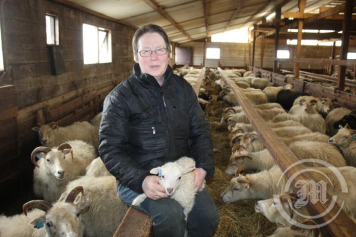
Mayor: Guðrún Karólína Reynisdóttir
Telephone: 438 1536
Email: helgafellssveit341@gmail.com
http://ssv.is/sveitarfelog/helgafellssveit/
